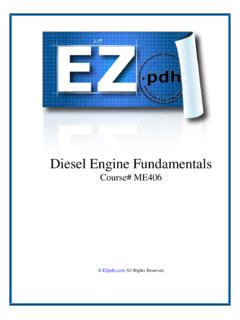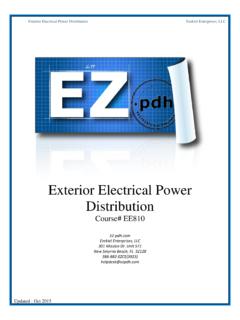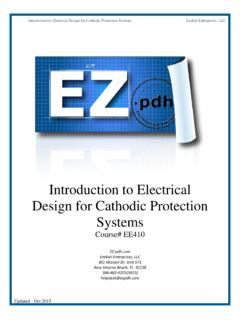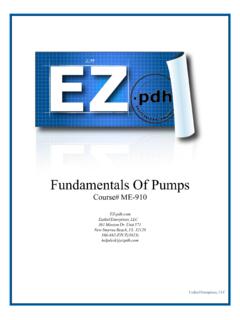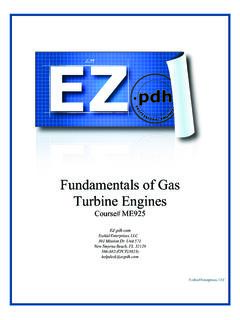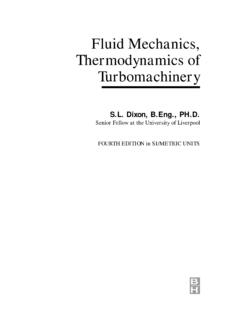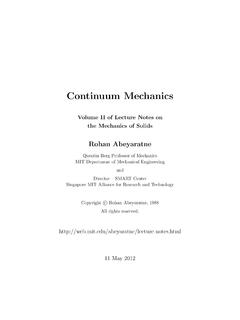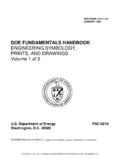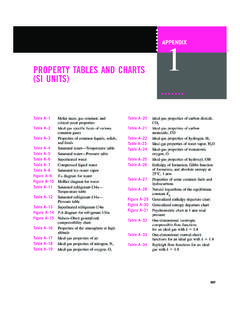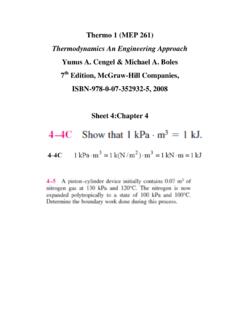Transcription of Basic Electrical & DC Theory
1 Basic Electrical & DC Theory Course# EE601 All Rights Reserved DOE-HDBK-1011/1-92 JUNE 1992 DOE FUNDAMENTALS HANDBOOKELECTRICAL SCIENCEV olume 1 of Department of EnergyFSC-6910 Washington, 20585 Distribution Statement A. Approved for public release; distribution is document has been reproduced directly from the best available to DOE and DOE contractors from the Office of Scientific and Technical O. Box 62, Oak Ridge, TN 37831; (615) to the public from the National Technical Information Service, Department ofCommerce, 5285 Port Royal Rd., Springfield, VA No. DE92019785 Electrical SCIENCERev. 0 ESABSTRACTThe Electrical Science Fundamentals Handbook was developed to assist nuclear facilityoperating contractors provide operators, maintenance personnel, and the technical staff withthe necessary fundamentals training to ensure a Basic understanding of Electrical Theory ,terminology, and application.
2 The handbook includes information on alternating current (AC)and direct current (DC) Theory , circuits, motors, and generators; AC power and reactivecomponents; batteries; AC and DC voltage regulators; transformers; and Electrical testinstruments and measuring devices. This information will provide personnel with a foundationfor understanding the Basic operation of various types of DOE nuclear facility Words: Training Material, Magnetism, DC Theory , DC Circuits, Batteries, DCGenerators, DC Motors, AC Theory , AC Power, AC Generators, Voltage Regulators, ACMotors, Transformers, Test Instruments, Electrical DistributionELECTRICAL SCIENCERev. 0 ESFOREWORDThe Department of Energy (DOE) Fundamentals Handbooks consist of ten academicsubjects, which include Mathematics; Classical Physics; Thermodynamics, Heat Transfer, andFluid Flow; Instrumentation and Control; Electrical Science; Material Science; MechanicalScience; Chemistry; Engineering Symbology, Prints, and Drawings; and Nuclear Physics andReactor Theory .
3 The handbooks are provided as an aid to DOE nuclear facility handbooks were first published as Reactor Operator Fundamentals Manuals in1985 for use by DOE category A reactors. The subject areas, subject matter content, and levelof detail of the Reactor Operator Fundamentals Manuals were determined from several Category A reactor training managers determined which materials should be included, andserved as a primary reference in the initial development phase. Training guidelines from thecommercial nuclear power industry, results of job and task analyses, and independent input fromcontractors and operations-oriented personnel were all considered and included to some degreein developing the text material and learning DOE Fundamentals Handbooks represent the needs of various DOE nuclearfacilities' fundamental training requirements.
4 To increase their applicability to nonreactor nuclearfacilities, the Reactor Operator Fundamentals Manual learning objectives were distributed to theNuclear Facility Training Coordination Program Steering Committee for review and update their reactor-specific content, DOE Category A reactor training managers alsoreviewed and commented on the content. On the basis of feedback from these sources,information that applied to two or more DOE nuclear facilities was considered generic and wasincluded. The final draft of each of the handbooks was then reviewed by these two groups. Thisapproach has resulted in revised modular handbooks that contain sufficient detail such that eachfacility may adjust the content to fit their specific handbook contains an abstract, a foreword, an overview, learning objectives, andtext material, and is divided into modules so that content and order may be modified byindividual DOE contractors to suit their specific training needs.
5 Each subject area is supportedby a separate examination bank with an answer DOE Fundamentals Handbooks have been prepared for the Assistant Secretary forNuclear Energy, Office of Nuclear Safety Policy and Standards, by the DOE TrainingCoordination Program. This program is managed by EG&G Idaho, SCIENCERev. 0 ESOVERVIEWThe Department of Energy Fundamentals Handbook entitled Electrical Science wasprepared as an information resource for personnel who are responsible for the operation of theDepartment's nuclear facilities. A Basic understanding of electricity and Electrical systems isnecessary for DOE nuclear facility operators, maintenance personnel, and the technical staff tosafely operate and maintain the facility and facility support systems.
6 The information in thehandbook is presented to provide a foundation for applying engineering concepts to the knowledge will help personnel more fully understand the impact that their actions may haveon the safe and reliable operation of facility components and Electrical Science handbook consists of fifteen modules that are contained in fourvolumes. The following is a brief description of the information presented in each module of 1 of 4 Module 1 - Basic Electrical TheoryThis module describes Basic Electrical concepts and introduces 2 - Basic DC TheoryThis module describes the Basic concepts of direct current (DC) Electrical circuitsand discusses the associated 2 of 4 Module 3 - DC CircuitsThis module introduces the rules associated with the reactive components ofinductance and capacitance and how they affect DC 4 - BatteriesThis module introduces batteries and describes the types of cells used, circuitarrangements, and associated SCIENCERev.
7 0 ESModule 5 - DC GeneratorsThis module describes the types of DC generators and their application in termsof voltage production and load 6 - DC MotorsThis module describes the types of DC motors and includes discussions of speedcontrol, applications, and load 3 of 4 Module 7 - Basic AC TheoryThis module describes the Basic concepts of alternating current (AC) electricalcircuits and discusses the associated 8 - AC Reactive ComponentsThis module describes inductance and capacitance and their effects on 9 - AC PowerThis module presents power calculations for single-phase and three-phase ACcircuits and includes the power triangle 10 - AC GeneratorsThis module describes the operating characteristics of AC generators andincludes terminology, methods of voltage production, and methods of parallelingAC generation 11 - Voltage RegulatorsThis module describes the Basic operation and application of voltage 4 of 4 Module 12 - AC MotorsThis module explains the Theory of operation of AC motors and discusses thevarious types of AC motors and their SCIENCERev.
8 0 ESModule 13 - TransformersThis module introduces transformer Theory and includes the types oftransformers, voltage/current relationships, and 14 - Test Instruments and Measuring DevicesThis module describes Electrical measuring and test equipment and includes theparameters measured and the principles of operation of common 15 - Electrical Distribution SystemsThis module describes Basic Electrical distribution systems and includescharacteristics of system design to ensure personnel and equipment information contained in this handbook is by no means all encompassing. An attemptto present the entire subject of Electrical science would be impractical. However, the ElectricalScience handbook does present enough information to provide the reader with a fundamentalknowledge level sufficient to understand the advanced theoretical concepts presented in othersubject areas, and to better understand Basic system and equipment of EnergyFundamentals HandbookELECTRICAL SCIENCEM odule 1 Basic Electrical TheoryBasic Electrical TheoryTABLE OF CONTENTSTABLE OF CONTENTSLIST OF ivLIST OF AND ITS 1 The 1 Electrostatic 2 The First Law of 3 Electrostatic 3 Potential 5 Free 8 Electrical 10 Real and Ideal 12 UNITS OF Electrical 13 System Internationale (SI) Metric 14 Ohm s 16 Rev.
9 0 Page iES-01 TABLE OF CONTENTSB asic Electrical TheoryTABLE OF CONTENTS (Cont.) 18 METHODS OF PRODUCING VOLTAGE (ELECTRICITY).. 19 Static 20 Magnetic 21 Piezoelectric 22 Photoelectric 23 Thermionic 27 Magnetic 29 Magnetic Flux 29 Magnetic 31 Polarity of a Single 31 Magnetic Field and Polarity of a 32 Magnetomotive 33 Field 36 MAGNETIC 37 Magnetic 37BH Magnetization 40 Magnetic 41 Faraday s Law of Induced 42 Lenz s 44ES-01 Page iiRev. 0 Basic Electrical TheoryTABLE OF CONTENTSTABLE OF CONTENTS (Cont.) Electrical 47 APPENDIX A Metric System and Powers of 0 Page iiiES-01 LIST OF FIGURESB asic Electrical TheoryLIST OF FIGURESF igure 1 The 1 Figure 2 The Carbon 2 Figure 3 Electrostatic 2 Figure 4 Electrostatic 3 Figure 5 Electrostatic Field Between Two Charges of Opposite 4 Figure 6 Electrostatic Field Between Two Charges of Like 4 Figure 7 Potential Difference Between Two Charged 5 Figure 8 Energy Shells and Electron 6 Figure 9 Electron Flow Through a Copper Wire with a Potential 11 Figure 10 Potential Difference Across a Conductor Causes a Current to 11 Figure 11 Voltaic Chemical 20 Figure 12 Static 20 Figure 13 Generator - Electromagnetic 21 Figure 14 Pressure Applied to
10 Certain Crystals Produce an Electric 22 Figure 15 Heat Energy Causes Copper to Give up Electrons to 23 Figure 16 Producing Electricity from Light Using a Photovoltaic 24 Figure 17 Vacuum Tube 25 Figure 18 Electron Spinning Around Nucleus Produces Magnetic 27 Figure 19 Magnetic 28 Figure 20 The Law of Magnetic Attraction and 28ES-01 Page ivRev. 0 Basic Electrical TheoryLIST OF FIGURESLIST OF FIGURES (Cont.)Figure 21 The Magnetic Field Produced by Current in a 31 Figure 22 Left-hand Rule for Current Carrying 31 Figure 23 Left-hand Rule for 32 Figure 24 Left-hand Rule to Find North Pole of an 33 Figure 25 Different Physical Forms of 35 Figure 26 Magnetic Current with Closed Iron 38 Figure 27 Typical BH Curve for Two Types of Soft 39 Figure 28 Hysteresis Loop for Magnetic 41 Figure 29 Induced 42 Figure 30 Electrical 46 Rev.
